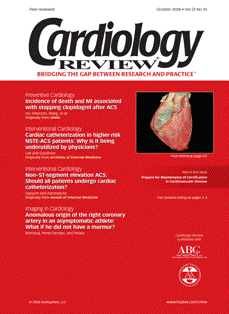Selective invasive management in a middle-aged man with chest pain and a normal cardiovascular workup
A 45-year-old white man presented to the emergency department with a 1-week history of intermittent pain in the middle of his chest, accompanied by upper abdominal discomfort.
A 45-year-old white man presented to the emergency department with a 1-week history of intermittent pain in the middle of his chest, accompanied by upper abdominal discomfort. The episodes lasted 5 to 15 minutes, and the patient reported experiencing an episode of chest pain at work earlier in the day, which went away but then returned as he was driving home from his office job that evening. He described this most recent episode of chest pain—which had subsided by the time he arrived at the emergency department—as nonradiating, squeezing, and 4 to 6 on a scale of 10 in intensity. The pain was associated with upper abdominal discomfort and nausea, but no vomiting. He noted occasional palpitations during these episodes, but no dizziness or shortness of breath. The patient had no medical history and had not seen a physician in more than 15 years. He did not use any medication on a regular basis, but occasionally took over-the-counter multivitamins. He had a 25-pack-year smoking history but had ceased smoking 2 years earlier, after his mother’s death from lung cancer. He had no history of alcohol or recreational drug use.
On physical examination, the patient had no chest pain and a normal temperature. His pulse rate was 86 beats per minute, and blood pressure was 168/92 mm Hg in the right arm and 166/92 mm Hg in the left arm. No localized tenderness in the chest or abdomen was observed on palpation. His electrocardiogram (ECG) was normal, and the results of his first set of cardiac enzymes were normal. After receiveing aspirin, heparin, a low-dose beta blocker, and an angiotensin-converting enzyme inhibitor, he was admitted to telemetry for observation. The patient’s serial cardiac enzymes were normal, as were his complete blood count and results of an extended metabolic panel. His low-density lipoprotein cholesterol was 168 mg/dL. The patient also underwent an exercise stress test, which was normal. He was discharged to home on an antiplatelet, antihypertensive, and lipid-lowering treatment regimen. Follow-up care was arranged with a primary care physician.
The patient in this case report presented with the signs and symptoms of myocardial ischemia, yet his ECG and cardiac enzymes were normal. He was treated using a selective invasive strategy and underwent a stress echocardiogram, which was normal. The patient was discharged to home on appropriate medical therapy, which needed to be optimized on an outpatient basis.
